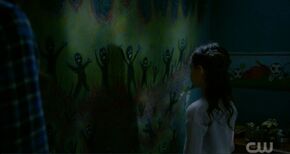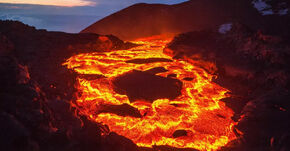
Amy's drawing about the next catastrophe.
A lake of fire appears, in both ancient Egyptian and Christian religion, as a place of after-death destruction of the wicked. The phrase is used in four verses of the Book of Revelation. Such a lake also appears in Plato's Phaedo, explicitly identified with Tartarus, where the souls of the wicked are tormented until it is time for them to be reborn, and where some souls are left forever. The image was also used by the Early Christian Hippolytus of Rome in about the year 200 and has continued to be used by modern Christians. Related is Jewish Gehenna which, among other things, is a valley near Jerusalem where trash was burned.
The new Antichrist, Amy Calder, have already drawn paintings about this event she will cause in the future.[1][2]
"Lake of fire" in the Book of Revelation[]

Lake of fire artwork.
The Book of Revelation, written some time in the last half of the first century, has five verses that mention a "lake of fire":
- Revelation 19:20: "And the beast was taken, and with him the false prophet that wrought miracles before him, with which he deceived them that had received the mark of the beast, and them that worshipped his image. These both were cast alive into a lake of fire burning with brimstone."
- Revelation 20:10: "And the devil that deceived them was cast into the lake of fire and brimstone, where the beast and the false prophet are, and shall be tormented day and night for ever and ever."
- Revelation 20:14-15: "Then Death and Hades[3] were cast into the lake of fire. This is the second death. And anyone not found written in the Book of Life was cast into the lake of fire."[NKJV]
- Revelation 21:8 "But as for the cowardly, the faithless, the detestable, as for murderers, the sexually immoral, sorcerers, idolaters, and all liars, their portion will be in the lake that burns with fire and sulfur, which is the second death."[4]
A commonly accepted and traditional interpretation is that the "lake of fire" and the "second death" are symbolic of eternal pain, pain of loss and perhaps pain of the senses, as punishment for wickedness.[5][6][7][8][9][10][11]
References[]
- ↑ "Spark of Hope"
- ↑ "Houston, We Have a Problem"
- ↑ The King James Version of Template:Bibleverse and the 21st Century King James Version have "hell" where some more-modern versions have "Hades" (a transliteration of the Greek word in the text).
- ↑ Cf. Template:Bibleverse; Template:Bibleverse-nb
- ↑ "'The lake of fire'" appears as a place of punishment, of perpetual torment, not of annihilation (20:10). The beast (19:20); the pseudo-prophet (19:20; 20:10); the devil (20:10); the wicked of varying description (20:15; 21:8), are cast into it. When the same is affirmed of death and Hades (20:14), it is doubtful whether this is meant as a mere figure for the cessation of these two evils personified, or has a more realistic background in the existence of two demon-powers so named (compare Isaiah 25:8; 1 Corinthians 15:26,54; 2 Esdras 7:31)" (The International Standard Bible Encyclopedia, Vol. III:1822)
- ↑ The Book of Revelation: A Commentary on the Greek Text, by Gregory K. Beale (Wm. B. Eerdmans Publishing, 1999 ISBN 978-0-8028-2174-4, p. 1035]
- ↑ A Commentary on the Revelation of John, by George Eldon Ladd (Wm. B. Eerdmans Publishing, 1972 ISBN 0-8028-1684-3, p. 258]
- ↑ The Last Things. A Survey of Biblical Eschatology (Kensington Theological Academy ISBN 1-4357-2224-8, p. 122
- ↑ All the Doctrines of the Bible: a study and analysis of major Bible doctrines, by Herbert Lockyer (Zondervan, 1988 ISBN 0-310-28051-6, p. 292
- ↑ Revelation Commentary
- ↑ Dr Grant C. Richison
